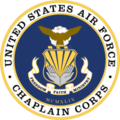In the United States armed forces, the chiefs of chaplains of the United States are the senior service chaplains who lead and represent the Chaplain Corps of the United States Army, Navy, and Air Force. The Navy created the first Office of the Chief of Chaplains in 1917; the Army followed in 1920, and the Air Force established its own in 1948 after it became a separate branch.
Contents
The three chiefs of chaplains and the three active-duty deputy chiefs of chaplains from the Army, Navy, and Air Force comprise the Armed Forces Chaplains Board (AFCB) which provides advice and recommendations to OSD officials (the secretary of defense and the under secretary of defense for personnel and readiness) on policies and issues related to the free exercise of religion and on all matters concerning religion, spiritual readiness, morality, ethics, morale, and military chaplains, in addition to a number of policy issues. [1] [2] [3]
The current military chiefs of chaplains are:
| Name | Photo | Rank and service | Chaplain Corps emblem | Position | Appointed |
|---|---|---|---|---|---|
| William Green Jr. |  | Major General US Army |  | Chief of Chaplains of the United States Army | Dec 5, 2023 |
| Gregory N. Todd |  | Rear Admiral US Navy |  | Chief of Chaplains of the United States Navy | May 16, 2022 |
| Trent C. Davis |  | Major General US Air Force |  | Chief of Chaplains of the United States Air Force | August 9, 2024 |

